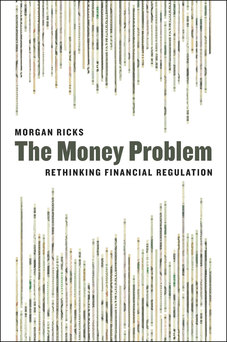
The Money Problem, released this March, is in my opinion indispensable in understanding the current debates around financial reform, and is a must-read for anyone seriously interested in money and banking.
This book is especially timely given the long-running argument this past year between Bernie Sanders and Hillary Clinton over how to move beyond Dodd-Frank in regulating the financial system. Sanders staked out the claim that it is necessary to break up the big banks, while Clinton hedged by saying that the priority should be imposing new rules on “shadow banks” outside the regulated banking system, that themselves can and have been the center of panics.
There’s been a lot of confusion about this. Which strategy is better, from the perspective of decreasing risks to the financial system, is a question that cannot really be answered using the normal vocabulary used to talk about finance and banking.
In this book, Vanderbilt law professor Morgan Ricks provides the concepts needed to resolve that and a number other live debates surrounding financial regulation and monetary policy. It’s not an easy read and is intended at an academic/policy audience, but it’s a must-read for those groups.
The basic thesis of the book is that financial problems -- namely panics -- are fundamentally issues of monetary design. The fragility of a financial system, no matter what its structure or the extent of financial regulation or oversight, is really a function of the underlying monetary system.
“The failure to specify a functional legal definition of what constitutes a monetary instrument is the original sin of banking law, and it is the main source of our current regulatory troubles,” Ricks writes.
Basically, the problem is that the banking system can fail when people, as a group, freak out about the possibility that their claims for money won’t be honored. In that scenario, banks can undergo It’s a Wonderful Life-style panics, and shadow banks can do the same, as the 2008 crisis and the panic surrounding the Reserve Primary Fund money market mutual fund showed.
Yet the government has failed to design a monetary system that ensures the availability of money when it’s needed, to prevent panics, and allowed inherently unstable forms of money creation -- such as the shadow banking sector.
The government issues and regulates cash, but, crucially, the private sector creates other forms of money that are are unregulated in ways that leads to confusion, miscalculation, and ultimately instability.
Of course, there’s endless confusion about what money is.
In Ricks’ book, money is simply a reliable store of nominal value.
Currency, such as paper dollar bills, are money. Bank deposits are money, even though private companies are able to create such money at will. So are all short-term cash-like instruments that everyone can be assured will be accepted as payment and doesn’t have a risk of losing value, relative to cash.
(Just as an inside: That definition is where Ricks adds to Gary Gorton, the Yale economist and former AIG consultant who has written his own explanation of the financial crisis that itself was highly valuable. Gorton described the problem as a failure of “safe assets.” People came to regard certain financial instruments, namely AAA-rate mortgage-backed securities, as functionally as safe as government-backed currency, meaning that they didn’t have to worry about the specific characteristics of the securities or their issuers. But when the housing bubble burst, suddenly they discovered that those securities were actually highly sensitive to changing information about, for example, the underlying value of mortgages. Ricks’ extends this analysis by explaining that moneyness has to do with short-term debt, whereas Gorton’s information sensitive/insensitive distinction applies to debts of all maturities, including long-term bonds that are clearly not money.)
Ricks’ solution is to prohibit money creation outside of a government-chartered banking system. No other firms could issue debt instruments that would be redeemable on demand for government-backed money. The chartered banks would operate in a public-private partnership with the government, subject to capital and portfolio regulations and paying the government a fee for the seignorage rights.
The system sounds a little complex, but Ricks suggests it wouldn’t be too big of an adjustment for banks that current receive FDIC insurance and are assessed fees for it.
Whether or not the solution is plausible, however, the bigger contribution of the book is to diagnose the problems facing the financial system today.
That in turn raises the question of why a law professor, and not a monetary economist, is the one to shed light on the realities of the monetary system and its interactions with the financial architecture of the country. The apparent answer is that these are considerations that have been thought through before, by figures as diverse as John Maynard Keynes, Alexander Hamilton, and Irving Fisher. But it seems they’ve been forgotten in part because the past mistakes made in monetary system design -- for example, placing a false dichotomy between physical currency and bank deposits -- became baked into the academic and policy consciousness.
This book is especially timely given the long-running argument this past year between Bernie Sanders and Hillary Clinton over how to move beyond Dodd-Frank in regulating the financial system. Sanders staked out the claim that it is necessary to break up the big banks, while Clinton hedged by saying that the priority should be imposing new rules on “shadow banks” outside the regulated banking system, that themselves can and have been the center of panics.
There’s been a lot of confusion about this. Which strategy is better, from the perspective of decreasing risks to the financial system, is a question that cannot really be answered using the normal vocabulary used to talk about finance and banking.
In this book, Vanderbilt law professor Morgan Ricks provides the concepts needed to resolve that and a number other live debates surrounding financial regulation and monetary policy. It’s not an easy read and is intended at an academic/policy audience, but it’s a must-read for those groups.
The basic thesis of the book is that financial problems -- namely panics -- are fundamentally issues of monetary design. The fragility of a financial system, no matter what its structure or the extent of financial regulation or oversight, is really a function of the underlying monetary system.
“The failure to specify a functional legal definition of what constitutes a monetary instrument is the original sin of banking law, and it is the main source of our current regulatory troubles,” Ricks writes.
Basically, the problem is that the banking system can fail when people, as a group, freak out about the possibility that their claims for money won’t be honored. In that scenario, banks can undergo It’s a Wonderful Life-style panics, and shadow banks can do the same, as the 2008 crisis and the panic surrounding the Reserve Primary Fund money market mutual fund showed.
Yet the government has failed to design a monetary system that ensures the availability of money when it’s needed, to prevent panics, and allowed inherently unstable forms of money creation -- such as the shadow banking sector.
The government issues and regulates cash, but, crucially, the private sector creates other forms of money that are are unregulated in ways that leads to confusion, miscalculation, and ultimately instability.
Of course, there’s endless confusion about what money is.
In Ricks’ book, money is simply a reliable store of nominal value.
Currency, such as paper dollar bills, are money. Bank deposits are money, even though private companies are able to create such money at will. So are all short-term cash-like instruments that everyone can be assured will be accepted as payment and doesn’t have a risk of losing value, relative to cash.
(Just as an inside: That definition is where Ricks adds to Gary Gorton, the Yale economist and former AIG consultant who has written his own explanation of the financial crisis that itself was highly valuable. Gorton described the problem as a failure of “safe assets.” People came to regard certain financial instruments, namely AAA-rate mortgage-backed securities, as functionally as safe as government-backed currency, meaning that they didn’t have to worry about the specific characteristics of the securities or their issuers. But when the housing bubble burst, suddenly they discovered that those securities were actually highly sensitive to changing information about, for example, the underlying value of mortgages. Ricks’ extends this analysis by explaining that moneyness has to do with short-term debt, whereas Gorton’s information sensitive/insensitive distinction applies to debts of all maturities, including long-term bonds that are clearly not money.)
Ricks’ solution is to prohibit money creation outside of a government-chartered banking system. No other firms could issue debt instruments that would be redeemable on demand for government-backed money. The chartered banks would operate in a public-private partnership with the government, subject to capital and portfolio regulations and paying the government a fee for the seignorage rights.
The system sounds a little complex, but Ricks suggests it wouldn’t be too big of an adjustment for banks that current receive FDIC insurance and are assessed fees for it.
Whether or not the solution is plausible, however, the bigger contribution of the book is to diagnose the problems facing the financial system today.
That in turn raises the question of why a law professor, and not a monetary economist, is the one to shed light on the realities of the monetary system and its interactions with the financial architecture of the country. The apparent answer is that these are considerations that have been thought through before, by figures as diverse as John Maynard Keynes, Alexander Hamilton, and Irving Fisher. But it seems they’ve been forgotten in part because the past mistakes made in monetary system design -- for example, placing a false dichotomy between physical currency and bank deposits -- became baked into the academic and policy consciousness.

